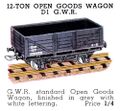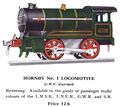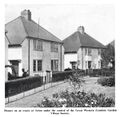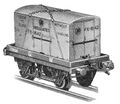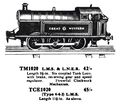Category:Great Western Railway
| The "Big Four" railway companies |
|---|
 |
| Great Western Railway (GWR) |
| London, Midland and Scottish Railway (LMS) |
| London and North Eastern Railway (LNER) |
| Southern Railway (SR) |
Isambard Kingdom Brunel [image info]
1840 2-2-2- locomotive "Fire Fly" [image info]
1903: GWR's Cornwall "Helton and Lizard" bus service [image info]
The Cornish Riviera Express, started by the GWR in 1904 [image info]
1925 advert for holidaying in Cornwall [image info]
GWR road transport - lorry and horse and cart [image info]
Housing built by the GWR in Acton, London [image info]
Railway Air Services, instigated by Imperial Airways and the GWR, and then launched as a joint project with the rest of the Big Four [image info]
1935 100-year Anniversary publication, "Great Western Progress: 1835-1935" [image info]
1940s: Mini-submarine body manufactured by the GWR during World War Two [image info]
A Hornby No.2 Special loco, showing GWR colour, styling, and brass steam valvework "cone" [image info]
GWR "Titley Court" (Bing for Bassett-Lowke), gauge 1 [image info]
The Great Western Railway (GWR) (known to enthusiasts as "God's Wonderful Railway") was founded in 1833, set up by Bristol as a reaction to Liverpool's emergence as a more popular port. In order to stay relevant, Bristol decided to create their own railway network for the West of England, and hired a young Isambard Kingdom Brunel to survey routes and design the infrastructure.
The GWR prided themselves on their engineering prowess, and Brunel designed the GWR track to use broad gauge to provide a superior ride. Even though the railway later moved to standard gauge, the fact that much of the railway had originally been designed to take wider trains meant that the 1935 Cornish Riviera Express could use wider and more luxurious coaches.
The GWR preserved its name during the 1922/23 railway grouping and became one of the Big Four railway companies, acquiring more routes in Wales and Western England, and was finally absorbed into the new British Railways network in 1948, becoming BR's "Western Region".
Networks
Although the GWR spread over Wales and Southwest England, its key nodes were the London terminus at Paddington and the port at Bristol. The company also embraced air travel and bus routes, and part of Brunel's vision was for the network to extend to New York via the SS Great Western (1838) transatlantic steamship built by Brunel, for the Bristol-New York route.
Notable engineering
The GWR achieved a number of engineering records and "firsts". Broad-gauge track was technically superior to standard gauge, and some of the GWR tunnels (the Box Tunnel, and then the Severn Tunnel) were the longest railway tunnels in the world when they were built. The SS Great Western was initially the world's largest passenger ship, and revolutionised transatlantic travel by proving the concept that larger ships were more fuel-efficient, and the Maidenhead Railway Bridge was the longest span-for-height brick bridge in the world. Disbelief at the proportions of the Maidenhead bridge was so strong that the GWR management were reluctant to have the bridge's temporary wooden former "scaffolding" removed, and a crowd assembled at the first crossing by a steam locomotive in 1839, to see if it fell down.
Livery and styling
The GWR's steam locomotives were green, although the exact shade (and the lining) changed a couple of times.
One of the more distinctive features of the GWR locos was their use of shiny brass valvework instead of a steam dome - this feature was so distinctive that Meccano Ltd. implemented it as a physical feature on the GWR versions of their early Hornby gauge 0 locos - initially, Hornby's loco versions for the other railway companies were physically identical and only differentiated by their paintwork and markings, so their decision to make an exception for GWR was notable.
Further reading
- E.T. MacDermot, C.R. Clinker, History of the Great Western Railway, Volume 1 1833-1863 (Ian Allan, 1964) ISBN 0711004110
- E.T. MacDermot, C.R. Clinker, History of the Great Western Railway, Volume 2 1863-1921 (Ian Allan, 1964) ISBN 0711004129
- O.S. Nock, History of the Great Western Railway, Volume 3 1921-1947 (Ian Allan, 1967) ISBN 0711003041
External links
museums and preservation societies
- STEAM – Museum of the Great Western Railway, Swindon (steam-museum.org.uk)
- Didcot Railway Centre – Home of the Great Western Society (didcotrailwaycentre.org.uk)
- Southall Railway Centre – Home of the Great Western Railway Preservation Group, GWRPG (gwrpg.co.uk)
- Great Western (Severn Valley Railway) Association, GW(SVR)A (gw-svr-a.org.uk)
- Museum of Science and Industry, MOSI, Great Western Warehouse (mosi.org.uk)
- Newton Abbot Town and GWR Museum (museum-newtonabbot.org.uk)
information and archives
- The Great Western Alliance (steam-museum.org.uk)
- The Great Western Archive (greatwestern.org.uk)
- Great Western Railway Journal, index (gwrjournal.com)
- The Broad Gauge Society, BGS (broadgauge.org.uk)
- Great Western Study group, GWSG (gwsg.org.uk)
- GWR locos (steamindex.com)
- Great Western Society, Bristol Group (gwsbristol.org)
- Great Western Railway Engineering Works, Swindon (historypin.org)
- GWR Station Colours (stationcolours.info)
- Everything GWR (everythinggwr.com)
- The GWR Webring (yourtakeonbusiness.com)
Brunel and the GWR
- Isambard Kingdom Brunel and the Great Western Railway (brunel200.com)
- Great Western Railway (ikbrunel.org.uk)
models and modelling
Subcategories
This category has the following 3 subcategories, out of 3 total.
Pages in category ‘Great Western Railway’
The following 40 pages are in this category, out of 40 total.
B
C
- Cattle Truck 8-ton GWR 106324 (Hornby Dublo D1)
- Cattle Truck GWR 106324 (Hornby Dublo D1)
- Centaur locomotive (100Y)
- County of Bedford locomotive 3821 (Hornby Series E220)
- County of Northampton locomotive 3410 (Bing for Bassett-Lowke, gauge 1)
- County of Northampton locomotive 3410 (Bing for Bassett-Lowke, gauge 3)
G
- Goods Brake Van GW 68796 Park Royal (Hornby Dublo D1)
- Goods Train Set, GWR, Tank Loco 6699 (Hornby Dublo EDG7)
- Goods Van 12-Ton GWR 112699 (Hornby Dublo D1)
- Goods Wagon, GW, pb (Hornby Series)
- GPV Gunpowder Van, GW, grey (Hornby Series)
- Great Western 0-6-0 tank locomotive 2783 (Beeson for Bassett-Lowke)
- Great Western 5500 locomotive, 6V (Hornby EPM16)
- GWR - God's Wonderful Railway (Train Running Day)
- GWR Express Cartage Service Van B4157 (Triang Minic 79M)
- GWR locomotive 2936 "Titley Court" (Bing for Bassett-Lowke, gauge 1)
- GWR Railcar (Dinky Toys 26)
L
T
Media in category ‘Great Western Railway’
The following 81 files are in this category, out of 81 total.
- 20 Ton Brake Van GWR (Airfix Railway System 54363-5).jpg 1,600 × 906; 756 KB
- Adderley Hall GWR 4901 (WBoR 14ed).jpg 1,600 × 770; 352 KB
- Bassett-Lowke GWR 2936, Titley Court (BL-MR 1937-11).jpg 1,472 × 2,276; 616 KB
- Bassett-Lowke Models are World Famous (TRM 1925-09).jpg 1,632 × 2,504; 682 KB
- Bassett-Lowke, King George V 6000, gauge 0 (BL-MR 1937-11).jpg 1,541 × 2,130; 510 KB
- Cattle Truck GWR, Hornby Dublo D1 (HBoT 1939).jpg 560 × 526; 80 KB
- Containers, road-rail, GWR (TRM 1929-03).jpg 1,060 × 1,600; 293 KB
- Cornish Riviera Express (RWW 1935).jpg 2,189 × 3,000; 5.21 MB
- Famous Trains 3 Cornish Riviera Express.jpg 588 × 800; 146 KB
- Firefly 2-2-2 locomotive (GWP 1935).jpg 2,400 × 1,848; 788 KB
- Goods Brake Van GW, Hornby Dublo D1 (DubloBrochure 1938).jpg 545 × 505; 81 KB
- Goods Brake Van GW, Hornby Dublo D1 (HBoT 1939).jpg 569 × 512; 76 KB
- Goods Train Set, Hornby Dublo EDG7 (DubloBrochure 1938).jpg 2,118 × 871; 429 KB
- Goods Van 12-Ton GWR, Hornby Dublo D1 (DubloBrochure 1938).jpg 503 × 503; 74 KB
- Goods Van 12-Ton GWR, Hornby Dublo D1 (HBoT 1939).jpg 576 × 516; 57 KB
- Great Western Progress 1835-1935, front cover (GWP 1935).jpg 1,373 × 2,200; 739 KB
- Great Western Suburban Train Set, Airfix Railway System 54056-0 (AirfixRS 1976).jpg 3,000 × 2,116; 2.99 MB
- GWR - God's Wonderful Railway.jpg 1,920 × 1,080; 148 KB
- GWR 2936 loco 'Titley Court' (Bing for Bassett-Lowke, gauge 1).jpg 800 × 600; 264 KB
- GWR Duke of Connaught Locomotive, Matchbox Y14-1 (MBCat 1959).jpg 1,843 × 1,165; 648 KB
- GWR Pannier in N Gauge (GFN 1970).jpg 3,000 × 2,171; 558 KB
- GWR Pannier Tank Engine, card model (Trix1800 SC7).jpg 1,465 × 1,155; 859 KB
- GWR Pannier Tank loco, 00-gauge, Graham Farish (GF 1964).jpg 2,905 × 1,833; 598 KB
- GWR Prairie Tank loco, 00-gauge (GF 1964).jpg 2,885 × 1,865; 624 KB
- GWR Rail Car, Dinky Toys 26 (MCat 1939).jpg 1,125 × 633; 59 KB
- GWR Rail Car, Dinky Toys No 26 (1935 BHTMP).jpg 573 × 379; 29 KB
- GWR road transport (BRIPAW 1944).jpg 1,600 × 885; 410 KB
- GWR Six-Wheeled Milk Van, Ratio Scale Models No709 (WandH 1958-02).jpg 1,200 × 532; 260 KB
- GWR Standard Wooden Coaches (Milbro 1930).jpg 2,634 × 2,558; 869 KB
- GWR Suburban Brake Coach, Airfix 54250-0 (AirfixRS 1976).jpg 2,745 × 1,086; 1.49 MB
- GWR Train Running Day 2014.jpg 310 × 425; 56 KB
- Helton and Lizard road service, GWR, 1903 (GWP 1935).jpg 1,800 × 1,390; 555 KB
- Holidays on the Ocean Coast, GWR (TRM 1925-09).jpg 786 × 1,200; 189 KB
- Hornby 3C GWR Cornish Riviera box end (~1927).jpg 720 × 356; 128 KB
- Hornby Book of Trains cover 1926.jpg 650 × 490; 125 KB
- Hornby Book of Trains cover 1927-28.jpg 656 × 482; 134 KB
- Hornby Book of Trains cover 1938-39.jpg 657 × 495; 136 KB
- Hornby Brake Van GW (1926 HBoT).jpg 1,453 × 1,243; 199 KB
- Hornby E020 Locomotive, GWR 2251 (HBoT 1934).jpg 2,121 × 1,393; 423 KB
- Hornby E120 Special Locomotive GWR 2301 (HBoT 1934).jpg 1,057 × 707; 137 KB
- Hornby E120 Tank Locomotive, GW 4560 (HBoT 1934).jpg 2,005 × 1,369; 373 KB
- Hornby EPM16 Special Tank Locomotive, GWR 5500 (HBoT 1934).jpg 2,025 × 1,533; 478 KB
- Hornby No1 Locomotive GW 2449 (HBoT 1930).jpg 962 × 496; 89 KB
- Hornby No1 Locomotive, GWR 4300 (HBoT 1934).jpg 1,920 × 1,709; 346 KB
- Hornby No1 Tank Loco, GW Goods or Passenger (1926 HBoT).jpg 972 × 710; 122 KB
- Hornby No1 Tank Locomotive GW (HBoT 1929).jpg 1,373 × 955; 207 KB
- Hornby No2 locomotive, GW 2711.jpg 1,024 × 575; 444 KB
- Hornby No2 Pullman Set, GW (1926 HBoT).jpg 1,925 × 731; 189 KB
- Hornby No2 Special Electric Tank Locomotive GW 2221 (HBoT 1930).jpg 1,481 × 966; 264 KB
- Hornby No2 Special Locomotive GWR 3821 County of Bedford (HBoT 1938).jpg 1,553 × 970; 195 KB
- Hornby No2 Special locomotive, GWR 3821 County of Bedford, detail.jpg 1,024 × 768; 408 KB
- Hornby No2 Special Passenger Locomotive and Tender GW 3821 (HBoT 1929).jpg 1,946 × 1,334; 344 KB
- Hornby No2 Special Tank Locomotive, GW 2221, detail.jpg 1,024 × 576; 331 KB
- Housing in Acton, Great Western (London) Garden Village Society (GWP 1935).jpg 1,400 × 1,361; 394 KB
- Insulated Container, GWR FX-1642, Hornby Series (MM 1936-09).jpg 660 × 574; 99 KB
- King George V GWR 6000, Cornish Riviera Express (WBoR 14ed).jpg 2,500 × 1,763; 1.14 MB
- King George V locomotive 6000 (Marklin).jpg 1,200 × 675; 504 KB
- King George V, GWR Broad Gauge locos(Micromodels HM2).jpg 3,000 × 2,083; 2.84 MB
- Locomotive 0-6-0, GWR LMS LNER, Märklin TM1020 (MarklinCRH ~1925).jpg 1,695 × 1,467; 846 KB
- Locomotive GWR 2253, 0-6-0, 5-inch gauge, steam, pic01 (John Cashmore).jpg 2,453 × 1,746; 2.3 MB
- Locomotive GWR 2253, 0-6-0, 5-inch gauge, steam, pic02 (John Cashmore).jpg 2,453 × 1,771; 2.17 MB
- Locomotive GWR 2253, 0-6-0, 5-inch gauge, steam, pic03 (John Cashmore).jpg 2,453 × 1,759; 2.18 MB
- Lorry being loaded with road-rail container, GWR (TRM 1929-03).jpg 1,600 × 935; 349 KB
- Maidenhead Bridge span model.jpg 1,200 × 468; 331 KB
- Michael Gilkes and Audrey Gilkes, riding locomotive GWR 2253 at Hove Park.jpg 2,138 × 3,000; 4.14 MB
- Model of Cardiff Docks for GWR (Twining).jpg 2,813 × 1,833; 847 KB
- North Star locomotive (GWP 1935).jpg 2,400 × 2,070; 822 KB
- Open Goods Wagon 12-Ton GWR, Hornby Dublo D1 (HBoT 1939).jpg 567 × 473; 50 KB
- Photograph of Isambard Kingdom Brunel (GWP 1935).jpg 903 × 1,200; 372 KB
- Portrait of Isambard Kingdom Brunel (GWP 1935).jpg 958 × 1,200; 370 KB
- Prairie 2-6-2T Tank Locomotive GWR 6110, Airfix 54151-1 (AirfixRS 1976).jpg 2,155 × 1,181; 1.04 MB
- Pre-Grouping Series locos (Micromodels PG2).jpg 3,000 × 2,067; 4.46 MB
- Railcraft GW-type Coach, 00-gauge (EBRMS Book06).jpg 1,600 × 798; 746 KB
- Realism, Bassett-Lowke (TRM 1928-05).jpg 691 × 1,024; 219 KB
- Submarine shell, WW2, GWR (ICNBR 1945).jpg 2,000 × 1,358; 595 KB
- Tank Locomotive GWR 6699, Hornby Dublo EDL7, profile (HBot 1939).jpg 1,219 × 433; 319 KB
- The Cornish Riviera, GWR (TRM 1925-01).jpg 1,624 × 2,500; 1.25 MB
- Three New Hornby Trains, Hornby No.3 locomotives (MM 1927-12).jpg 929 × 1,200; 527 KB



























